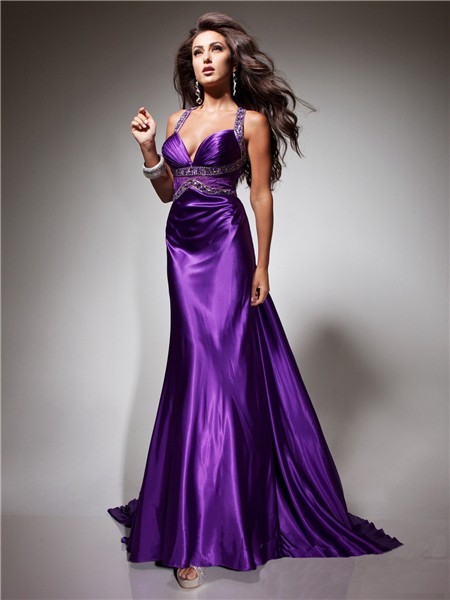Purple Silk Dress Biography
Source(google.com.pk)
The color purple has been associated with royalty, power and wealth for centuries. In fact, Queen Elizabeth I forbad anyone except close members of the royal family to wear it. Purple's elite status stems from the rarity and cost of the dye originally used to produce it.
Purple fabric used to be so outrageously expensive that only rulers could afford it. The dye initially used to make purple came from the Phoenician trading city of Tyre, which is now in modern-day Lebanon. Fabric traders obtained the dye from a small mollusk that was only found in the Tyre region of the Mediterranean Sea.
A lot of work went into producing the dye, as more than 9,000 mollusks were needed to create just one gram of Tyrian purple. Since only wealthy rulers could afford to buy and wear the color , it became associated with the imperial classes of Rome, Egypt, and Persia. Purple also came to represent spirituality and holiness because the ancient emperors, kings and queens that wore the color were often thought of as gods or descendents of the gods.
Sometimes, however, the dye was too expensive even for royalty. Third-century Roman emperor Aurelian famously wouldn't allow his wife to buy a shawl made from Tyrian purple silk because it literally cost its weight in gold. Talk about sticker shock.
Purple's exclusivity carried over to the Elizabethan era (1558 to 1603), during which time everyone in England had to abide by Sumptuary Laws, which strictly regulated what colors, fabrics and clothes could and couldn't be worn by different classes within English society. Queen Elizabeth I's Sumptuary Laws forbid anyone but close relatives of the royal family to wear purple, so the color not only reflected the wearer's wealth but also their regal status .
The hue became more accessible to lower classes about a century and a half ago. In 1856, 18-year-old English chemist William Henry Perkin accidently created a synthetic purple compound while attempting to synthesize quinine, an anti-malaria drug . He noticed that the compound could be used to dye fabrics, so he patented the dye and manufactured it under the name aniline purple and Tyrian purple, making a fortune in the process.
The color's name was later changed to "mauve" in 1859, based on the French name for the purple mallow flower, with chemists calling the dye compound mauveine. And that's how the elite royal color became widely available and affordable thanks to a young scientist's serendipitous experiment.
Today, clothes of all colours cost the same. But did you know that a few generations ago, the cost depended on the colour of the cloth? This was because dyes were expensive to obtain. Tyrian Purple was a dye so expensive that only kings could afford it!
Born in the Purple
Tyrian Purple (also called Royal Purple) dyes clothes a deep purple shade. In ancient times, it was extracted from the Mediterranean sea snail (Murex brandaris).
The extraction and trade of Tyrian Purple has been recorded since the 4th c. BC. Pliny the Elder, the famous Roman historian and scientist, has left us a description of how it was made:
After the snails are fished from the sea, the dye-bearing vein is extracted and crushed. For every hundred pounds of the juice, 20 ounces of salt are added, and left for three days. It is then set to boil slowly in vessels of tin [or lead], to concentrate the dye, for upto ten days. Then the cloth to be dyed is immersed into the boiling mixture. The boiling is continued until the cloth is dyed to the satisfactory shade. Red shades are considered inferior to blackish ones. Finally the cloth is left to soak until it has fully imbibed the colour.
Complicated isn't it?
Worth its weight in silver
It is said that it took 12,000 snails to produce just 1.4 grams of this dye. Because of this, it was so expensive, that the historian Theopompus reported that, "Purple for dyes fetched its weight in silver". Yet, there was a craze for this dye as a status symbol. In fact the Emperors of Byzantium made a law forbidding anybody from using it except themselves. The expression 'born in the purple' rose from this practice. In the picture, you can see the Emperor Justinian I dressed in a robe dyed with Tyrian Purple. Interestingly, unlike other dyes that faded in sunlight, Tyrian purple would become darker.
The Emperors of Byzantium made a law forbidding anybody from using Tyrian Purple except themselves. The expression 'born in the purple' rose from this practice.
Dyes ancient, Dyes modern
Until modern times, all dyes were made in a similar manner. For example, cochineal (which gives a crimson colour) was made from the scale insect Kermes vermilio. To make one pound of dye, 70,000 insect bodies were boiled, dried, powdered and boiled again in ammonia. The red dye was then extracted by filtration and precipitation by alum. Indigo was extracted from leaves of the indigo plant (Indigofera tinctoria). Leaves were soaked in water and fermented to produce the blue dye. This was then precipitated using lye (sodium hydroxide), dried and powdered. To make just a 100 g of dye, you'd need to grow 37 square metres of crop - that's why it was also called 'Blue Gold'!
In 1909, Paul Friedlander discovered the chemical structure of Tyrian Purple (now called 6,6-dibromoindigo). But by then, the nature of the dye industry had completely changed. New dyes were now being made from the by-products of coal extraction. The first of these was mauveine, synthesised by the British chemist William Henry Perkin from coal tar in 1856. As these dyes were cheaper and offered a wider range of colours, the need for natural dyes disappeared. And that's why the clothes we buy today and no longer priced on the basis of colour!









No comments:
Post a Comment